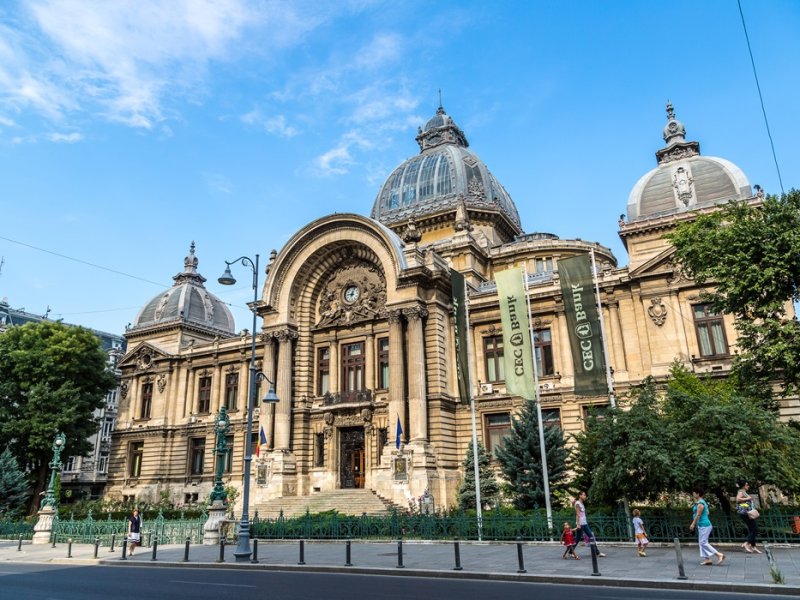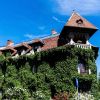CEC Palace – one of the most beautiful architectural symbols of Little Paris

By Bucharest Team
- Articles
If you go for a stroll in the central streets of Bucharest and look up from your phone to admire the surrounding buildings, you will feel like you've stepped back in the interwar times. And no, we're not exaggerating! That's exactly the feeling you'll get if you stop for a second and study the architecture of the buildings! Every palace and building and street have now become national symbols that preserve a single history in every piece of stone laid at its foundation.
One of the buildings that will surely transport you back to interwar Bucharest is the CEC Building on Victory Avenue, one of those architectural symbols of Little Paris that has remained a landmark of Bucharest's identity then and now.
CEC Palace - History and story of the place
If you arrive in front of the CEC Palace (Casa de Economii și Consemnațiuni), you will be fascinated by the imposing architecture and eclectic design of the building, which seem to speak for themselves about the period Romania was going through in the 19th century. But beyond the impressive building lies an almost paradoxical history of the place.
The CEC Palace was built on the site of the former St. John the Great monastery and inn, erected in the 16th century, in the time of Michael the Brave. It was a small wooden building, renowned for its miracles for the sick. Injured by time, the church began to deteriorate after a century, but it was saved in 1703, when Constantin Brâncoveanu restored it. A century later, the church was again in need of renovation, but this time nothing could be done and it was demolished in 1875.
On the remaining site, on July 8, 1897, construction began on the CEC building, with King Carol I of Romania and Queen Elisabeta attending the event.
CEC Palace - Architecture
The CEC Palace impresses with its architectural elegance and grandeur. The building was designed by French architect Paul Gottereau, known for his eclectic style combining elements of neoclassicism and baroque. In collaboration with the Romanian architect Ion Socolescu (who founded the Romanian Society of Architects and the first Romanian school of architecture), Gottereau created a grandiose edifice to house the headquarters of the House of Deposits, Consignments and Savings (CEC), founded in 1864 by the Romanian ruler Alexandru Ioan Cuza.
The main facade of the palace is decorated with Corinthian columns, arches and elaborate bas-reliefs, giving the building a monumental air. The main entrance is dominated by an imposing portico and a glass and metal dome, which allows natural light to flood the main hall, creating a spectacular effect.
The interior of the palace is equally impressive, with sumptuous halls decorated with marble, mosaics and stained-glass windows, reflecting the wealth and refinement of the period. For the most part, the palace is made of local materials - massive stone and Dobrogea marble. The walls and ceilings are decorated with exquisite paintings painted between 1900 and 1913 by Mihail Simonidi, a Romanian painter based in Paris.
The operations room, located under the central dome, is a vast and elegant space where customers enjoyed the services offered by CEC in an atmosphere of luxury and distinction.
The construction was completed in 1900 and since then the CEC has operated in this building without any notable alterations. Apart from the monumental beauty of this building, it is also a sturdy construction. It was not affected by any earthquakes, only the main dome suffered minor damage in the 1977 earthquake, nor was it affected by the terrible bombing that Bucharest was subjected to during the Second World War.
CEC Palace - The role of the CEC Palace in the history of Bucharest
Over the years, the CEC Palace has played a crucial role in Romania's economic and financial development. In the interwar period, the CEC was one of the most important financial institutions in the country, contributing significantly to sustaining the national economy.
In recent years, the CEC Palace has undergone a process of restoration and modernization, maintaining its function as the headquarters of CEC Bank, but also adapting to modern requirements. Today, the building is not only a place of financial activity but also an important tourist attraction, admired by visitors from all over the world.
CEC Palace - Visitor Information
Although public access to the interior of the CEC Palace is limited due to its function as an active banking headquarters, the exterior of the building can be admired at any time. Occasional organized tours offer a rare opportunity to explore the magnificent interior of the Palace and learn more about its fascinating history.
The CEC Palace remains an essential landmark of Bucharest, an architectural gem that continues to inspire and impress with its beauty and history. Whether you're an architecture enthusiast, a curious tourist or a resident of the capital, the CEC Palace is definitely worth a visit to discover its splendor and to take you faster to times long gone by.






























